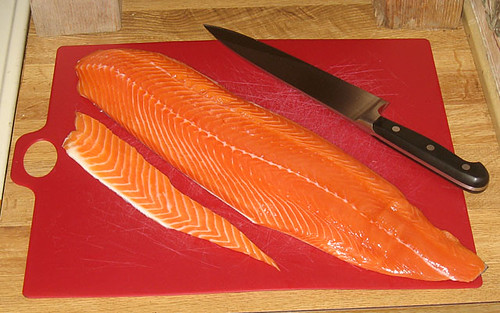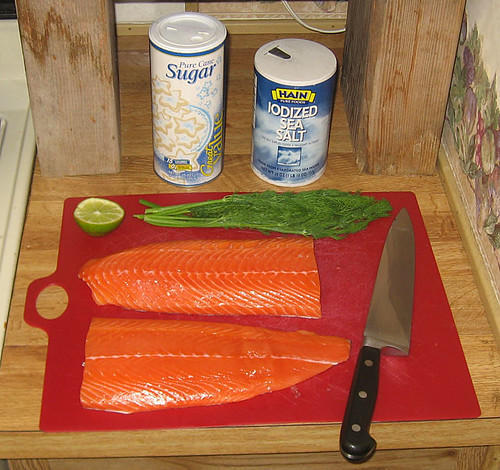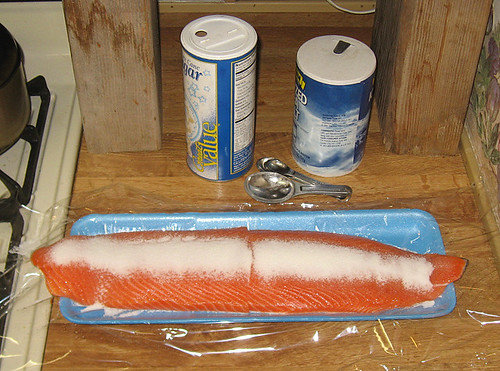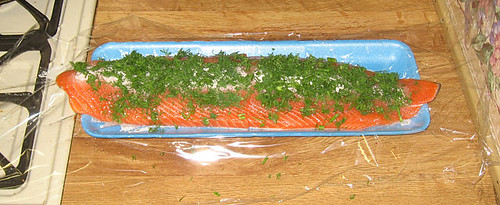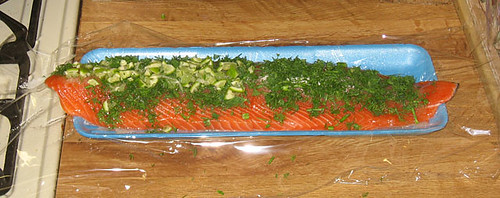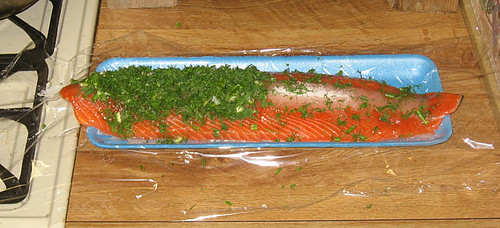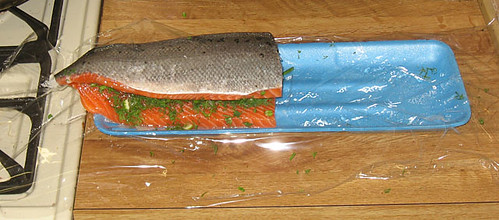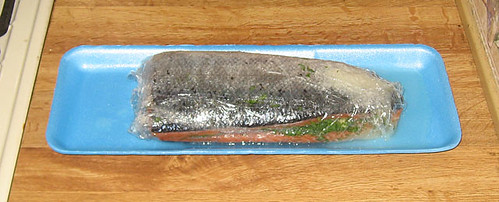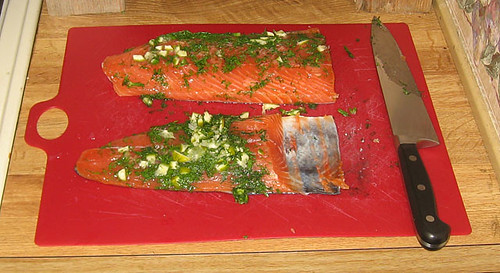It’s absolutely delicious when made well.
It impresses guests and significant others, because it’s exotic.
It’s dead easy to make, even if you’re a kitchen klutz…
…and nearly every recipe I’ve found on the Internet is wrong. Most of them produce gravlax that is either raw in the middle, hard and crusty on the outside, or tastes like a Styrofoam salt lick—which is a tragedy, because properly made gravlax is so delicious that I’ve eaten over a pound and a half at a single sitting! And the others make you go to a lot of extra work.
It’s taken several expensive experiments to get this recipe correct—and now I bring it to you.
Gravlax, Gravad Lax, Gravet Laks, Gravlaks, Graflax, Graavilohi, Graavilõhe
Gravlax (also known as gravad lax, gravet laks, gravlaks, graflax, graavilohi, or graavilõhe, depending on which Nordic country you’re from) was traditionally made by salting salmon and burying it in a hole dug at the ocean’s edge, just above the high tide line. Today we will improve on that technique by using refrigeration and fresh herbs.
Why This Gravlax Recipe Is The Best
First, I’ve stripped the process down to the essentials, skipping steps that don’t matter and streamlining the rest.
More importantly, though, most gravlax recipes add far too much salt—and then depend on ending the cure at exactly the right time. Too early, and the salmon is still mushy. Too late, and the surface is hard and salt-burned…and the outside always seems to end up harder than the inside no matter what you do.
In this recipe, however, you’ll use the correct amount of salt and sugar to cure the fish, and no more. Not only will it taste better, you won’t have to worry about timing!
(Note: if you’re willing to do the extra work and want the strictly traditional dish, here’s how. And if you disagree that this recipe is the best, feel free to leave a comment!)
Ingredients and Supplies You Will Need
Ingredients!
- 1.7 pounds (800 grams) of salmon filet, skin on. Do not get steaks! If you’re not doing an entire side at once like I do, get two smaller filets that are the same size. However much salmon you get, adjust quantities of salt, sugar, and lime appropriately, as per the table below. I find the recipe works better the more I fix at once: I’ve done two entire filets before, which was almost seven pounds!
- 3 tablespoons (45 ml) white sugar.
- 1 tablespoon (15 ml) salt. Sea salt is preferred, but whatever you use should be finely ground. (Do not use kosher salt, as the recipe will end up under-salted!)
- 1 oz. (28 grams) fresh dill. This is absolutely necessary. Don’t try to use dried dill. Trust me on this.
- 3 very thin lime slices. The secret ingredient! Don’t try to use lime juice: I’ll explain why later.
No, this recipe isn’t ‘paleo’ due to the white sugar…but please, please don’t try to use honey (or, Gods forbid, stevia) as the dry granulated sugar is necessary for the salmon to cure properly. Besides, there’s less sugar in the entire recipe than there is in a single 12-ounce can of Coke…and I’d rather have lots of healthy raw omega-3s plus a bit of fructose than hideous fake ‘bread’ made out of omega-6 laden nuts. Plus, this will give you an excuse to ask your hot neighbor “Hey, can I borrow a quarter cup of sugar?”
If you’re trying to avoid fructose entirely, you can use dextrose instead, although it won’t taste quite as good. UPDATE! If you’re zero-carb or VLC, commenter Johnnyv has successfully made a batch using xylitol. I haven’t tried it myself, but if you’re interested, click here to see how he did it. If you’re doing Whole 30, I don’t know what to tell you. Sorry about that.
Conversion Table
If you’re in between, average it out. The amount of dill isn’t critical: just cover the filets like you’ll see in the pictures below.
1 tablespoon = 3 teaspoons = ~45 ml.
| Weight of Salmon | Salt | Sugar | Lime |
| 3.4 pounds (1.55 kg) | 2 tablespoons (30 ml) | 6 tablespoons (90 ml) | 6 slices |
| 2.8 pounds (1.3 kg) | 5 teaspoons (25 ml) | 5 tablespoons (75 ml) | 5 slices |
| 2.25 pounds (1 kg) | 4 teaspoons (20 ml) | 4 tablespoons (60 ml) | 4 slices |
| 1.7 pounds (800g) | 1 tablespoon (15 ml) | 3 tablespoons (45 ml) | 3 slices |
| 1.1 pounds (500g) | 2 teaspoons (10 ml) | 2 tablespoons (30 ml) | 2 slices |
| 0.6 pounds (270g) | 1 teaspoon (5 ml) | 1 tablespoon (15 ml) | 1 slice |
You will also need:
- Plenty of plastic cling wrap
- A plate large enough to hold the salmon. If it came in a plastic tray, rinse it and use that.
- Measuring spoons. Don’t fake this: it is very important to get the proportions right.
- Paper towels.
- A cutting board.
- A sharp knife.
Gravlax: Step By Step Directions, With Pictures!
Step 1: Unwrap the filet, rinse it gently, and pat it mostly dry with a paper towel.
Step 2: If there’s a very thin part on one side (this is the belly), trim it off. Save it and eat it later, as it’s delicious!
Step 3: If you bought a single filet, cut it in half as precisely as you can.
Step 4: Place a layer of plastic wrap on top of the plate (or the plastic tray, if you saved it) that you’ll be curing the gravlax on. Then put the salmon filets on the tray. If you skip this step, you will make a big mess.
Step 5: Shake the salt and sugar over the thick parts of the filet. Don’t try to go all the way to the edge: it’ll soak through as it cures. Use more salt and sugar on the thick end of the filets, and less on the thin end.
Step 6: Mince the dill. Most recipes tell you to leave it whole, but you can use a lot less if you mince it—and I think gravlax tastes better with a few dill bits left on it.
Step 7: Distribute the dill over the filets.
Step 8: Cut three thin lime slices. Dice the slices and put them on top of only one of the two filets. (You’ll understand why in a moment.) Use slightly less lime than I used in the picture: this is a bit too much. It is important that the lime bits don’t touch the fish, or they’ll make little white acid burns. This is why you can’t use lime juice.
Do you have a zester? If so, instead of dicing lime slices, I recommend that you zest about half a lime and mix the zest in with the dill. Then you don’t have to move the dill back and forth or carefully distribute pieces of lime: you can simply pile the mixture all on one filet and skip to step 10. (Thanks to commenter Gail for the tip.)
If the table calls for 3 lime slices, zest about 1/2 lime. 6 lime slices = zest an entire lime. In between? Average it out.
If you don’t have a zester, or don’t know what a zester is, don’t worry…this is just a time-saver for people with lots of kitchen gadgets.
Step 9: Take the dill off of the other filet and put it on top of the filet with the limes. Remember, you need to keep the lime bits from touching the fish.
Step 10: Make a big salmon sandwich by putting one filet on top of the other. This is why you put most of the ingredients on one filet: if you try to tip one filet onto the other while it’s covered in dill and lime bits, you’ll make a huge mess.
Step 11: Wrap the filets as tightly as you can in the layer of plastic wrap you put under them.
Step 12: Wrap the filets in at least two more layers of plastic: one around, one lengthwise. Wrap as tightly as you can: you want the filets to be touching each other at all points, with no air space. The easiest way is to lay a few big sheets of plastic wrap out on the table and roll them up.
Step 13: Put the filets in the refrigerator. Make sure they’re on the tray or plate, because they’ll leak no matter how well you’ve wrapped them.
Step 14: Traditional recipes tell you to put a weight on top of the filets while they’re curing, and to remove and re-baste them during the cure. This isn’t necessary if you’ve wrapped them tightly…but you do need to turn them over a couple times. I flip mine morning and evening.
Step 15: This is the hardest part: wait two days. (Again, I recommend turning the package over twice a day.)
Unlike most recipes, curing time doesn’t need to be exact…it’s OK (though not perfect) after 36 hours, and I’ve left it to cure over three days and it tasted the same.
Intermission
And now, the delicious part!
Scrape the dill and lime debris off the top, and slice the gravlax as thinly as you can. For best results, slice diagonally so that you get the largest slices possible.
If you’re feeling frisky, you can present it nicely: it’s traditional to serve gravlax with a dill and mustard sauce (non-Facebook link) on crisp bread, often topped with a squeeze of lemon, a few capers, and some white pepper. (Another delicious suggestion involves lemon zest, orange zest, and juniper berries.) But as I am a bachelor and eat a paleo diet, I usually just stand over the cutting board and pop the slices straight in my mouth.
It’s probably good that salmon is expensive, or I’d be eating gravlax every day!
Live in freedom, live in beauty.
J. Stanton
- Feel free to explore gnolls.org: the index is a great place to start.
- If you’ve found that my recipe is indeed the best on the Internet, you can support my efforts to keep gnolls.org ad-free by buying a copy of my “Raw, powerful and brilliant,” “Insightful and surprisingly heartfelt,” “Funny, provocative, entertaining, fun, insightful,” “Totally engaging” novel, The Gnoll Credo. Buy it from Amazon.com, directly from 100 Watt Press (signed, at no extra cost), and worldwide.
